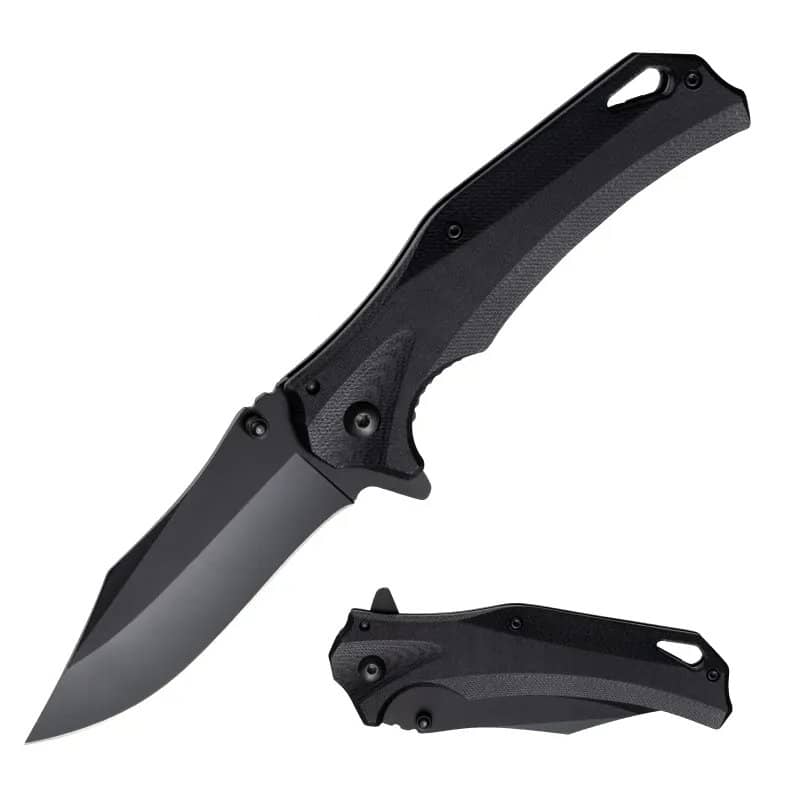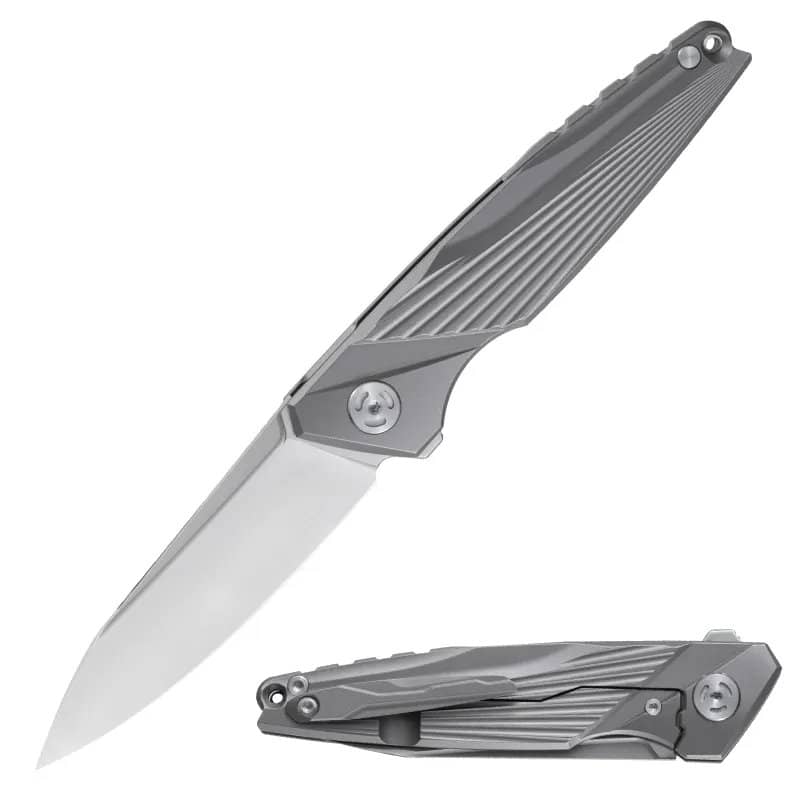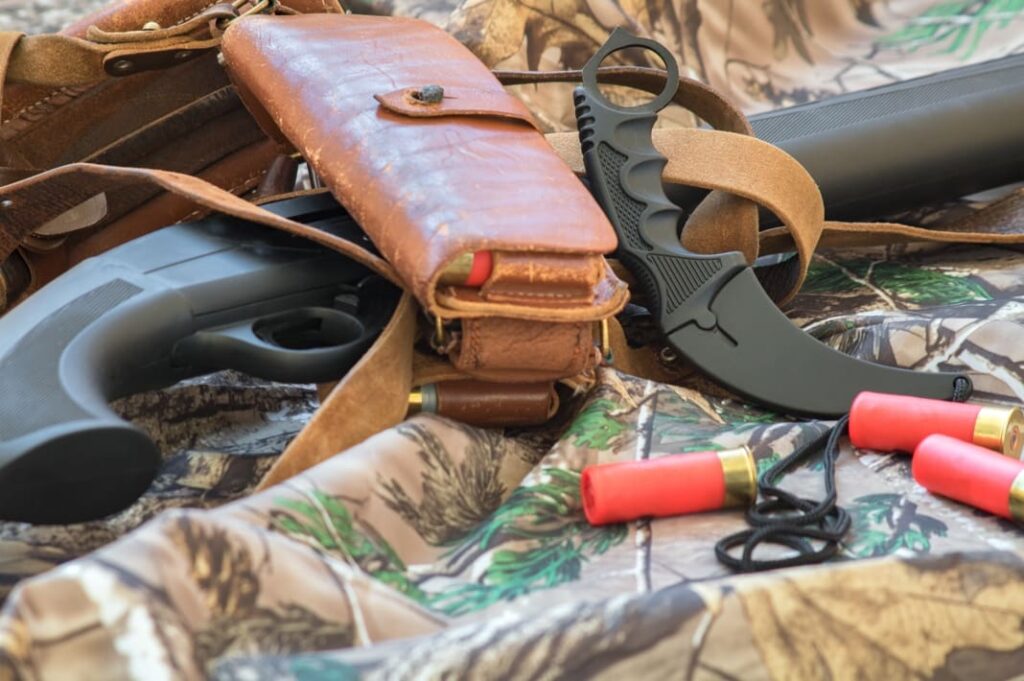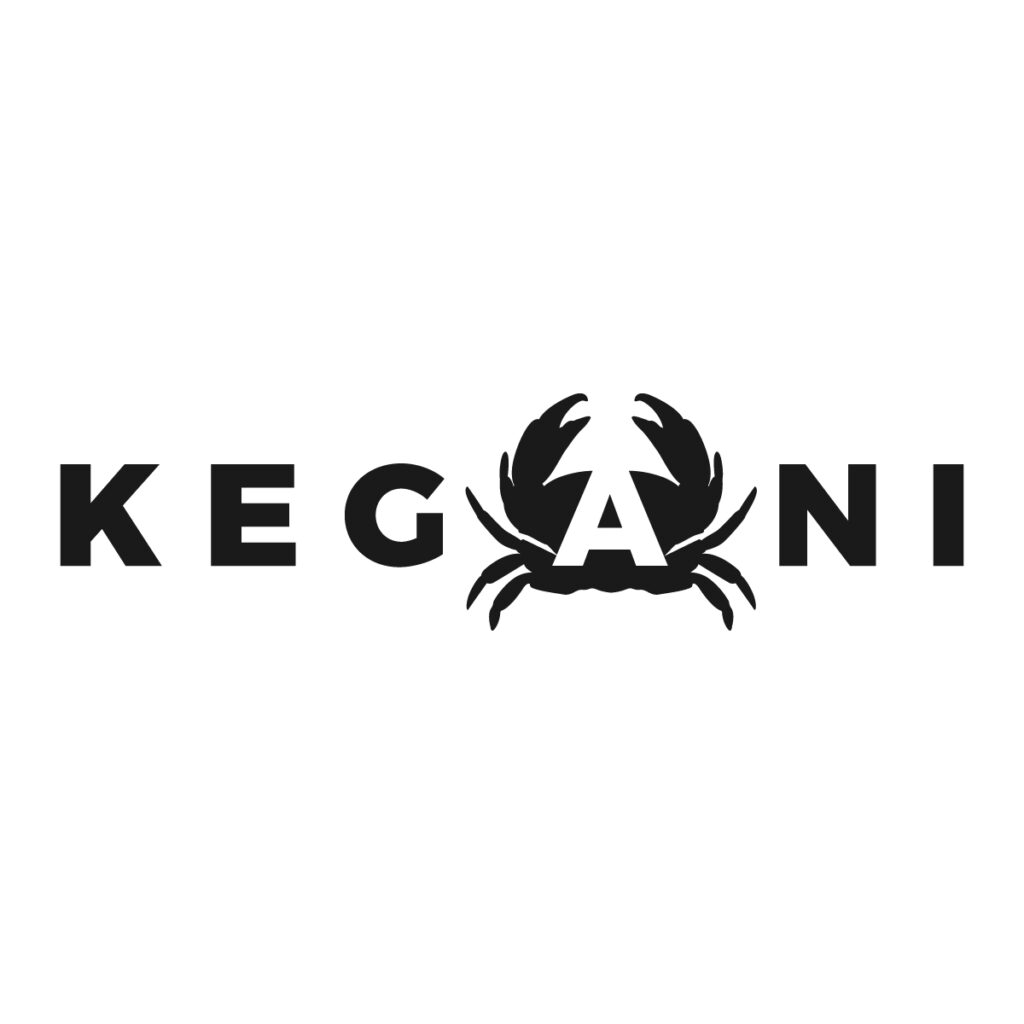Let’s be real—pocket knives come with a boatload of names and jargon that can make understanding them a real headache. Sure, having such variety in the world of pocket knives is awesome, but for beginners, it can also be a hindrance.
Take, for instance, our KKFK00047 model from the catalog. It’s labeled as a folding knife, an EDC knife, a side-opening knife, a manual-opening knife, and a drop point knife all at once. What’s the deal with all these names, right?
But fear not! Those dark days of pocket knife name chaos are behind us. In this ultimate guide, we’re laying out all the different types of pocket knives we can find, and we’re doing it with as much detail as possible. No more beating around the bush—let’s dive right in.
Folding and fixed blade knives
First things first, when selecting a pocket knife, you usually have two main options to mull over: folding knives and fixed-blade knives. They boil down to whether the blade can fold into the handle or not.
Folding knives
A folding knife is exactly what it sounds like—a knife where the blade can fold neatly into the handle. They usually come equipped with some kind of opening mechanism and a nifty lock to keep everything secure. Folding knives are the go-to for folks who value portability and need something for everyday carry.
- Portability: A folding knife is compact, with a blade that tucks away inside the handle. This makes it convenient to carry in your pocket without the need for a sheath.
- Versatility: Available in many styles and blade shapes much more than fixed blade knives. Folding knives are versatile tools for everyday cutting tasks.
Fixed-Blade knives
Fixed blade knives are the sturdy workhorses of the knife world, with a blade that’s permanently fixed atop the handle. With no moving parts, there’s less chance for them to go haywire when you need them the most.
- Strength: Fixed knives have a blade that extends into the handle, providing superior strength and stability for rigorous cutting tasks.
- Ease of maintenance: With no moving parts, fixed-blade knives are easier to clean and maintain.
- Reliability: You can rely on a fixed knife to perform consistently without the concern for mechanical failure of folding components.
Choosing between folding and fixed blade knives is a major decision. You gotta wrap your head around these two types before we dive into the next sections.
Start Working with a Professional Now
Types of pocket knives by blade shapes
Blade shapes refer to the contour or shape of the blade, basically how it’s curved or designed. Now, we’re not gonna go into crazy detail about every single blade shape here. We’ve got a whole separate guide for that. But we’ll give you the lowdown on some of the most buzzed-about blade shapes and what they’re all about.
Clip point

The clip point blade features a concave curve at the back near the tip, creating a thinner and sharper point. This design allows for controlled cutting and piercing, making it popular for hunting knives. Your clip point knife is ideal for detailed work.
Drop point
A drop point blade has a convex curve on the back near the tip, which results in a stronger point less prone to breaking. This blade shape is widely used for its versatility and is a solid choice for everyday tasks, as the point aligns with the center axis for better control.
Spear point
Spear point blades are symmetrical and taper to a point at the centerline, offering good balance. They’re often found on throwing knives and are designed for piercing, with their sharp points and ability to be sharpened on both sides for some versions.
Tanto point
The Tanto point, inspired by Japanese short swords, has a high point with a flat grind, leading to an extremely strong point. It’s best suited for thrusting and piercing, particularly through hard materials.
Sheepsfoot
A Sheepsfoot blade has a straight front edge and a curved back, which descends to the front edge. Your knife with this blade is optimized for slicing while minimizing the chances of accidental piercing due to the lack of a sharp point.
Hawkbill/Talon blade
The Hawkbill or Talon Blade shape resembles a claw, curving down towards the point, which makes it excellent for cutting and carving in a pull motion. Often used in gardening, this type of blade is also favored for cutting cables and stripping wire.
Types of pocket knives by opening mechanisms
Before we get into this section. Let’s first establish the fact that all knives with an opening mechanism are folding knives. That means there’s no such thing as an “assisted opening fixed blade knife.”
Folding pocket knives come in all shapes and sizes, and their opening mechanisms play a big role in how you whip out that blade. Getting a grip on these mechanisms is key to picking out the perfect knife for you.
Manual opening
Manual pocket knife relies on physical action to open the blade. Typically, you’ll find a thumb stud or a small protrusion on the blade to help your thumb grip and pivot the knife open. They lack springs but may have a pivot with adjustable tension to control the blade’s movement.
Assisted opening
Assisted-opening knives combine manual effort with an internal spring mechanism. Once you begin opening the blade with a thumb stud or similar device, the spring tension takes over to swiftly complete the action.
Automatic opening

Automatic knives, often called switchblades, allow you to open the blade with the press of a switch or button. These knives contain a spring in the handle that releases tension once activated, causing the blade to snap into place. The opening speed and ease make them distinct from manual and assisted openers.
Dual-action opening
Dual-action knives bring the best of both worlds, combining elements of both manual and automatic opening mechanisms. You can either flick open the blade manually using a thumb stud or similar feature, or you can opt for the automatic route, triggering the blade to deploy with a simple press of a button or switch.
This versatile design gives you the freedom to choose how you want to deploy your blade in any given situation, whether you prefer the precision of manual opening or the quickness of automatic action. Plus, it adds an extra layer of convenience and flexibility to your knife-wielding experience.
OTF and side-opening knives
Out the Front knives, commonly abbreviated as OTF knives, are characterized by their unique deployment mechanism, where the blade extends straight out from the front of the handle. These knives may feature a sliding button or switch that, when activated, propels the blade forward and locks it into position. OTF knives are prized for their lightning-fast deployment and sleek, futuristic design.
Side-opening knives, as the name suggests, open from the side of the handle rather than the front or top. These knives typically feature a blade that swings out from the side of the handle, often assisted by a thumb stud or flipper mechanism. Side-opening knives offer quick and easy access to the blade, making them a popular choice for everyday carry and tactical use. Their ergonomic design and smooth deployment make them a favorite among knife enthusiasts.
Start Working with a Professional Now
Types of pocket knives by uses and applications
Pocket knives are crafted with particular tasks in mind, giving you the flexibility to select a knife tailored to your activities. While not every knife is a one-trick pony, most are versatile enough to tackle multiple jobs. However, some knives excel in specific areas more than others. So, whether you need a blade for slicing, piercing, or any other task, there’s likely a pocket knife out there that’s perfect for the job.
EDC
Most everyday carry (EDC) knives are folding, offering a range of opening mechanisms such as manual, assisted opening, automatic, or dual action, and can further be categorized as side-opening or OTF knives. These versatile tools, designed for daily tasks, boast utility with single or multi-blade designs ideal for cutting, slicing, and tackling routine chores. Their compact and lightweight build ensures easy portability, making them indispensable companions for everyday use.
Hunting
Hunting knives are almost always considered with a fixed blade. While folding knives can technically serve as hunting knives, they’re not always the top choice in the market due to their inherent lack of durability compared to fixed-blade counterparts. Reason is tasks like hunting and skinning requires a steady knife.
Your go-to hunting pocket knife typically features a blade shape tailored for the job, such as a drop-point or skinning blade, perfect for field dressing game. Additionally, durability is paramount, with these knives crafted from strong, corrosion-resistant materials to withstand the rigors of the great outdoors.
Camping/Bushcraft/Survival
A knife that’s incredibly versatile, easy to carry, and boasts the durability akin to a hunting knife is the perfect candidate for a camping, bushcraft, or survival knife. The hallmark of these knives lies in their multifunctionality, capable of handling a diverse range of tasks in outdoor settings.
Tactical
Tactical knives are specifically designed to meet the needs of first responders and military personnel, offering essential features such as:
- Quick deployment: These knives are equipped with rapid one-handed opening mechanisms, ensuring swift access during critical moments.
- Added functions: Many tactical knives are outfitted with supplementary tools like glass breakers or seatbelt cutters, providing invaluable assistance in crisis situations and enhancing the knife’s utility for emergency responders and military professionals.
More knives, more names

As if things weren’t already complicated, there’s a whole slew of knives out there that defy standard categorization. And trust me, there are a ton of them. Many of these knives have names rooted in historical contexts, each boasting a distinctive design tailored for specific tasks or catering to the preferences of collectors. Let’s dive into a few of these unique specimens.
- Balisong: Also known as a butterfly knife, fan knife or Batangas knife. It is a knife with a split handle that rotates. Balisong is considered illegal in many states.
- Bowie knife: Bowie knives are known for their fixed blade design featuring a pronounced clip-point blade. Originally popularized by the legendary frontiersman Jim Bowie, these knives are characterized by their robust build and versatility. The clip-point blade, with its sharp, concave edge, excels in piercing and slicing tasks, making it a favorite among outdoorsmen and survivalists.
- Dirk: Dirk knives hold a special place in Scottish history, embodying a traditional design that has endured through the centuries. These knives are distinguished by their long, straight blades, which were once wielded by Scottish warriors and Highlanders as both weapons and tools.
- Stiletto: The stiletto knife is renowned for its sleek and slender blade, distinguished by its acute point designed for precise piercing. Originating in Italy, the stiletto has a long history dating back to the Renaissance era when it was favored as a concealed weapon by nobility and assassins alike. Its slender profile and sharp point make it ideal for thrusting and stabbing motions, earning it a reputation as a deadly yet elegant tool.
- Karambit: The Karambit is a unique knife with a curved blade that mimics the shape of a tiger’s claw, originating from Southeast Asia. This distinctive design provides the user with increased cutting power and versatility in various cutting tasks. The ergonomic handle is specifically crafted to fit snugly in the user’s hand, offering enhanced control and maneuverability during use.
- Navaja: The Navaja is a traditional Spanish folding blade knife, steeped in history and cultural significance. Characterized by its distinctive design, the Navaja features a long, slender blade that folds neatly into the handle when not in use. What sets the Navaja apart is its locking mechanism, which secures the blade in place when extended, providing added safety and stability during cutting tasks.
- Gentleman’s knife: Often elegant and compact with simple, refined blades for everyday use. In fact, any small and somewhat fashionable knife can be called a gentleman’s knife. One thing to note is that wooden handles are a common material among gentleman’s knives.
- Gravity knife: Many are also OTF knives, the gravity knife opens with the force of gravity alone. With a simple flick of the wrist or press of a button, the blade is released from its locked position and swings open under its own weight.
Which type of knife is best for you
There really isn’t a straight answer to which type of knife is best for you. If you are seriously considering buying in, or designing a knife for sell, each one is different. There is an answer, however, based on your vision and current target customers.
Ask yourself these questions: Are you running a camping site and in need of a reliable utility camping knife? Then consider a durable and versatile fixed-blade model with features like a sturdy blade and ergonomic handle for outdoor tasks. Or perhaps you’re opening an EDC gear store? In that case, a compact and lightweight folding knife like the CIVIVI’s Baby Banter would be the ideal choice, offering convenience and practicality for everyday carry enthusiasts.
Identify which benefits will resonate most with your customers and stock a variety of pocket knives to cover different preferences and applications. If you’ve got some killer knife designs brewing in your mind and you’re itching to bring them to life, finding the right manufacturer is crucial. That’s where Kegani steps in. With our team of dedicated and talented blacksmiths boasting decades of forging experience, we’re ready to turn your ideas into reality. Get in touch with us today to snag a quote on your dream knives!

